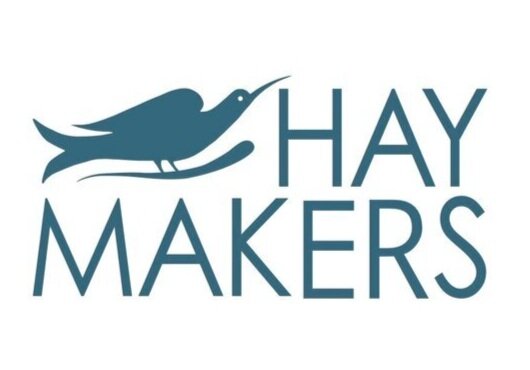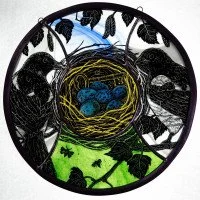Festival Exhibition
2025
Our Festival 2025 Exhibition features artists from across the United Kingdom, delivering Prints, Jewellery, Stained glass, Ceramic sculptures and Sculptural mobiles
Contact us directly if you would like to find out more about our artists featured below or purchase one of their pieces.
Charlotte Baxter
Charlotte is drawn to the natural world; exploring its rhythms and cycles in her work, as well as the ephemeral, dynamic beauty of the landscape.
Capturing the spirit or essence of a place is particularly important to her, as well as conveying a sense of movement and life in her pieces. Developing ideas from the ancient Celtic view of the natural world, she strives to capture the connection we have to the landscape, and the symbolism and meaning found in it.
She is particularly drawn to places where water meets the land, and her love of the sea and surfing gives her the opportunity for alternative and immersive experiences of the Welsh coastline – which has undoubtedly had an influence on her work.
Yvonne
Elston
Yvonne’s handmade sculptural ceramics explore the beauty of the curve. She takes inspiration from mid-century design to create pieces that are an interpretation rather than representation of the world around us. Her starting point is the cup of the palm and the flow of the hand - in a desire to create work that appears tactile and evokes a sense of tranquillity. Using hand building techniques and traditional slip-casting process, Yvonne can repeat forms, making pieces that stand alone or work in pairs. Finally, ancient glazing methods result in individually finished, unique effects.
Liz
Huppert
After graduating in BA Ceramics from Bath Academy of Art in 1989, Liz was introduced to the medium of stained glass by a friend. She was struck by the way that light illuminates glass and sends coloured patterns dancing onto walls.
Since then, she has established herself as a successful Stained Glass Artist, producing ornate glass artworks that can been seen hanging in homes all over the world.
She now works and teaches from her Worcestershire studio. Using traditional glass painting methods, such as sgraffito, and the Tiffany technique, Liz produce panels featuring British flora and fauna and the countryside around her home
Julia
Mathias
Julia is an independent jewellery designer working with silver, mixed metals and precious stones. Each piece she makes is hand made and unique and Julia takes a lot of inspiration from the colour and form of the stones and from the tactile qualities of jewellery from ancient civilisations. She enjoys exploring the relationship between gemstones in their more natural forms and the unyielding nature of metal – both being formed with immense heat and pressure.
Julia gained a degree in jewellery design at Middlesex University in her twenties but living and working in London took her in other career directions. In the last few years she has returned to her creative roots to invest her time and energy in what she truly loves- art and design.
Ed
Willis
Edward has no formal training in art; he has a degree in philosophy. He began making simple mobiles as nursery decorations for his children, becoming interested in the more elaborate sculptural possibilities of the form after seeing the work of Alexander Calder. He also takes inspiration from artists such as Barbara Hepworth, Brancusi and Naum Gabo. Although his work is largely abstract, it often relates to animal and plant forms and the sculptures might be seen as “suspended animations”, lying at rest, waiting for a passing breeze to breathe life into them.
In his kinetic sculptures, Edward explores ideas of fragility and strength as well as opposition and resolution. The pieces have a sense of harmony and tranquillity, and are intended to be enjoyed as elegant, striking forms and also as objects for contemplation and reflection. In a way that echoes both large institutions and individual personalities, each sculpture might outwardly appear to be in a state of stability, but actually relies for its existence on the continual internal tensions resulting from the pull of each part against every other, so that the whole piece is comprised of elements in a kind of “dynamic equilibrium”.





